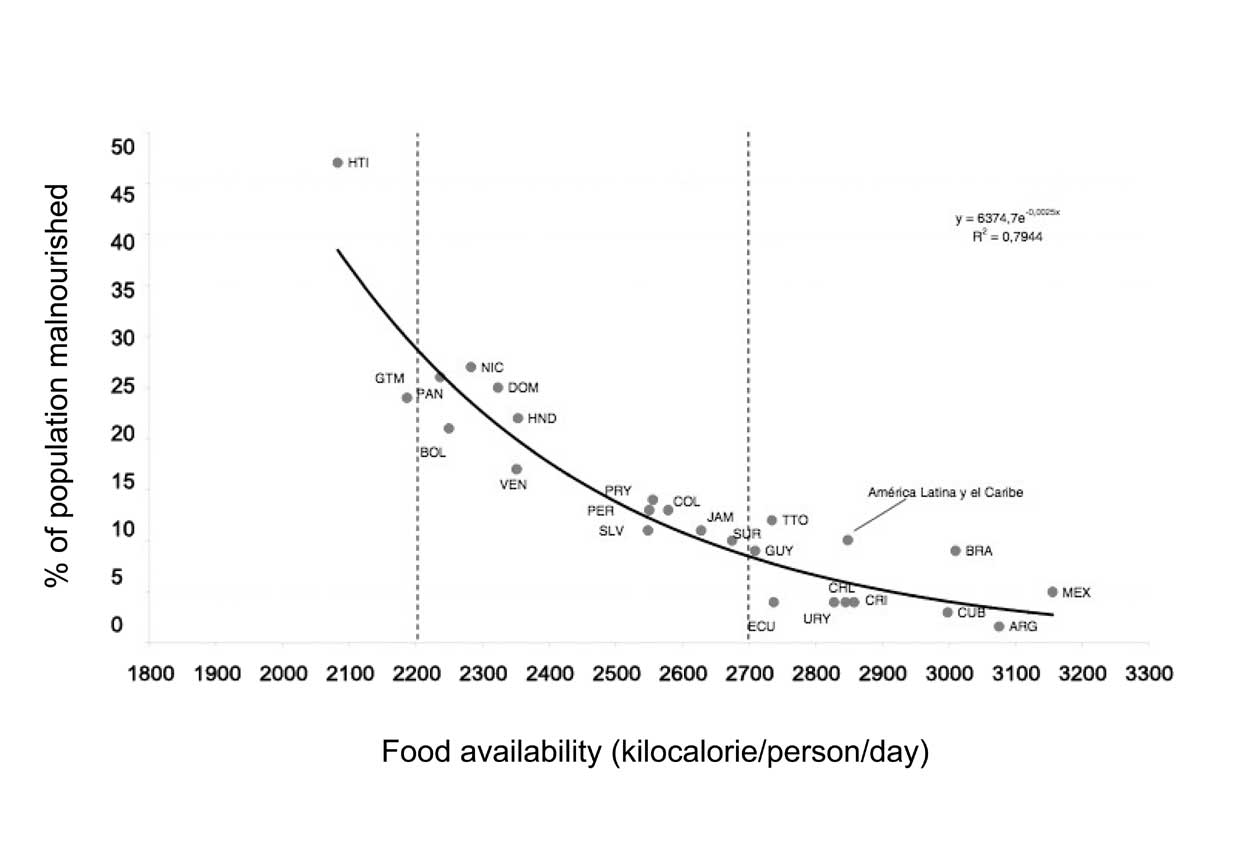
| Previous | Return to table of contents | Search Reports | Next |
| « Back to weltagrarbericht.de | ||
Agriculture in Latin America and the Caribbean: Context, Evolution and Current Situation | 5

Figure 1-1. Supply
of food and percentage of population malnourished in LAC countries 2000-2002.
Source: FAO, 2004.
|
The conceptual framework (Figure 1-2) taken as a reference for developing the content of this report seeks to understand and analyze the interrelations of the agricultural knowledge, science and technology systems, the agricultural production systems and the contextual factors and variables as a basis for retrospective and prospective analysis of their contribution to the attainment of the objectives of development and sustainability. The AKST systems can be understood as the set of actors (individuals and organizations), networks, configurations and interfaces among them that interact in generating, reconfiguring and disseminating information and technologies for innovation (institutional and technological) of agricultural production systems through processes of social learning regulated and guided by negotiated standards and rules for the purpose of improving the relationships among knowledge, technology, the environment and human development. The AKST systems aim to improve the performance indicators of agricultural production systems through processes of technological innovation. In the conventional approaches to systems, the vulnerability of agricultural production systems is conceived of based on the worldview of the outside expert who acts under his or her universal conception of reality on the local views and interests and reproduces a division of labor in the process of generating, accessing and using knowledge that transforms producers to mere receptacles of values, concepts and paradigms generated far from their context and without any commitment to their needs, demands, or aspirations. This linear mode of intervention, in which just a few generate, others transfer and the thousands of producers adopt the technological innovations, has prevailed in the last 50 years. To the contrary, in the Agricultural Knowledge and Information Systems (AKIS) approach, the systems are considered to be a social construct in which the actors who constitute it perceive their interdependence, come to agreement on the present and future systematic vision, negotiate |
principles, premises, objectives, strategies and courses of action and systematize their experiences and lessons through semi-structured processes of interpretation and intervention negotiated through the integrated management of knowledge and innovation. The integrated management of knowledge and innovation. The integrated management of knowledge and innovation suggests identifying the worldview-conception of reality-that conditions the ways of thinking and acting of those who interact to transform their reality and therefore is centered on the changing web of relationships and meanings that influence perceptions, decisions and actions in human initiatives. Accordingly, this mode of intervention considers the actors of the social context in which the new technologies are generated and applied as being co-responsible at every stage of the process of generating, validating and using the relevant information and technologies for innovation in agriculture. Agricultural production systems include all the activities for producing food, fibers, energy, biomass and environmental services such as landscape management and carbon sequestration. These productive and service activities entail the social and economic organization of the labor force, rural resources and information (direct drivers) with different performances in light of indicators such as efficiency, productivity, competitiveness, equity, quality and environmental sustainability. In processes of innovation, science and technology are important but not sufficient components for attaining the objectives of development and sustainability, as they are conditioned by variables and factors from the regional and global context in their different dimensions (indirect drivers), including social, economic, institutional, cultural, political and environmental. The critical external factors are capable of bringing to bear strong influences on agricultural production systems, determining internal obsolescences, shortcomings of capacities and resources and flaws in their relationship with the external environment. |
| Previous | Return to table of contents | Search Reports | Next |
| « Back to weltagrarbericht.de | ||